Detailed Risk Assessment: Health, Safety, and Compliance Analysis
VerifiedAdded on 2023/06/11
|12
|2643
|156
Report
AI Summary
This report provides a comprehensive risk assessment across various workplace scenarios, including an electrical technician's workshop, a mechanical engineering maintenance area, and a building construction site. It identifies applicable health and safety regulations such as the Management of Health and Safety at Work Regulations and the Electricity at Work Regulations. The report details the roles and responsibilities of employees and management in maintaining a safe work environment, emphasizing the importance of training, adherence to safety procedures, and cooperation among stakeholders. Hazards in a kitchen setting are identified and control measures are suggested to mitigate risks like overloaded circuits, improper storage, and flammable materials. A risk assessment for a gym is also presented, outlining measures for cyber security, floor safety, equipment maintenance, and locker room security. The report further discusses accident reporting procedures, the significance of RIDDOR, and the direct and indirect costs associated with workplace accidents, highlighting the importance of proactive safety measures and compliance with legal requirements.
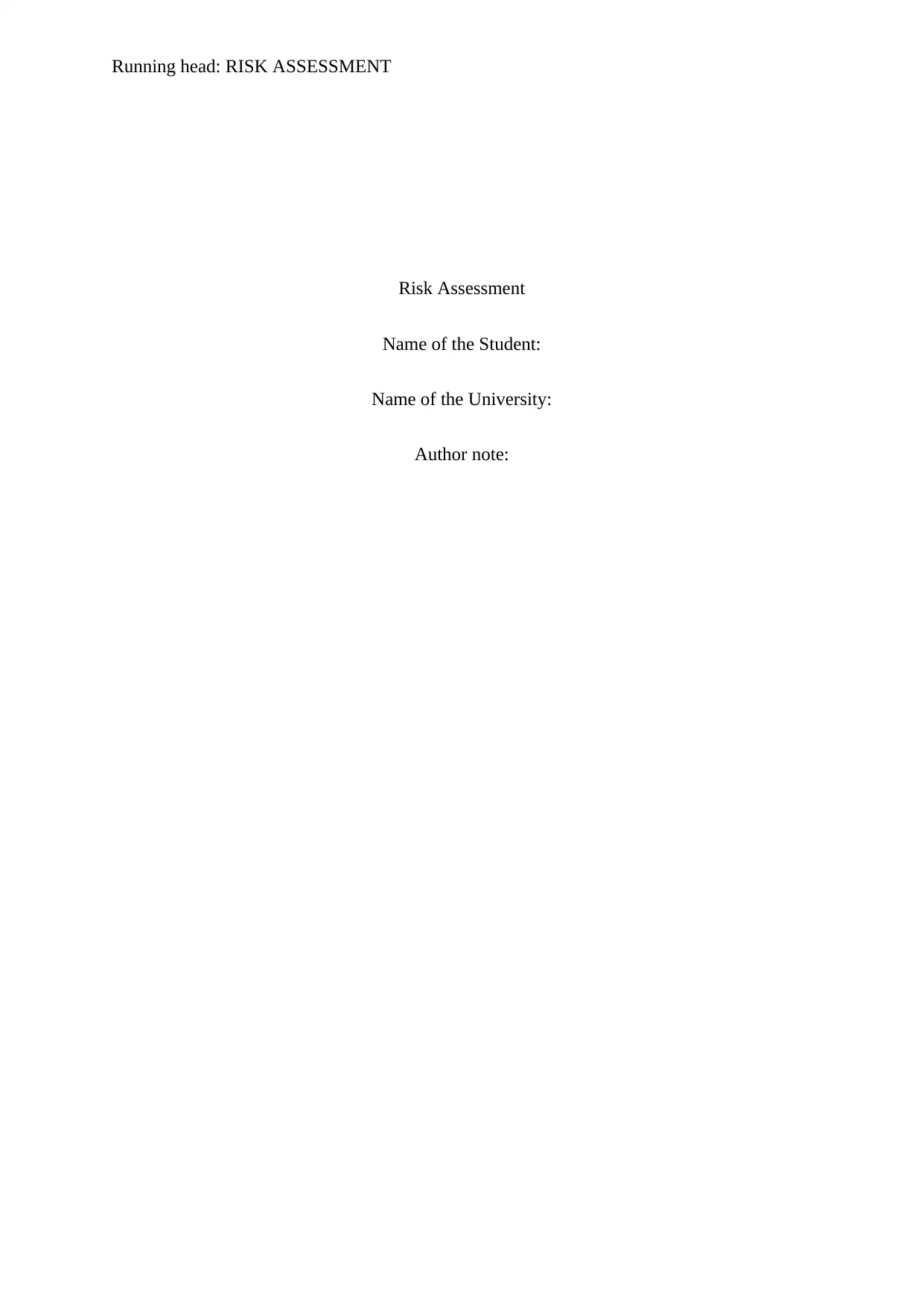
Running head: RISK ASSESSMENT
Risk Assessment
Name of the Student:
Name of the University:
Author note:
Risk Assessment
Name of the Student:
Name of the University:
Author note:
Secure Best Marks with AI Grader
Need help grading? Try our AI Grader for instant feedback on your assignments.
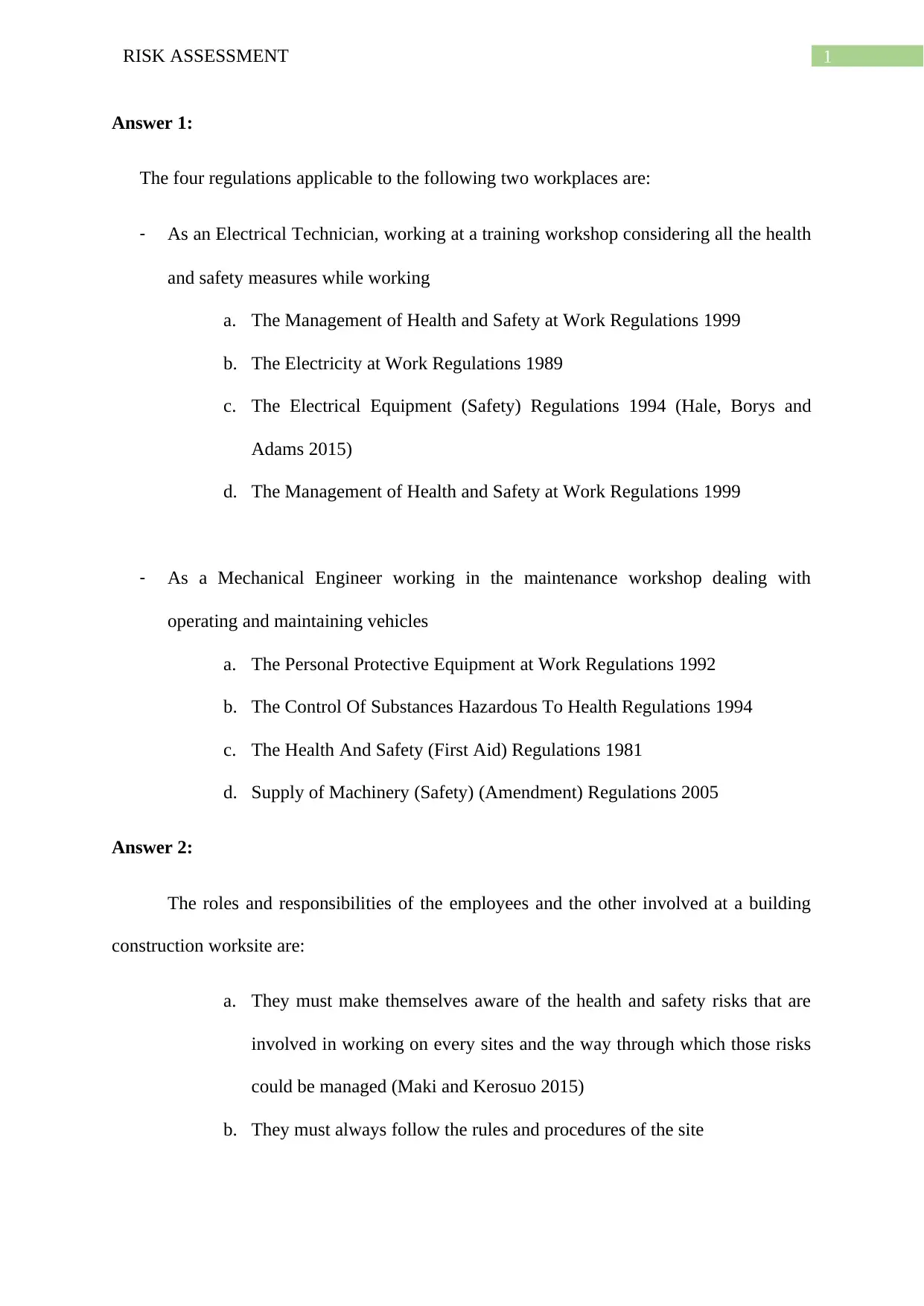
1RISK ASSESSMENT
Answer 1:
The four regulations applicable to the following two workplaces are:
- As an Electrical Technician, working at a training workshop considering all the health
and safety measures while working
a. The Management of Health and Safety at Work Regulations 1999
b. The Electricity at Work Regulations 1989
c. The Electrical Equipment (Safety) Regulations 1994 (Hale, Borys and
Adams 2015)
d. The Management of Health and Safety at Work Regulations 1999
- As a Mechanical Engineer working in the maintenance workshop dealing with
operating and maintaining vehicles
a. The Personal Protective Equipment at Work Regulations 1992
b. The Control Of Substances Hazardous To Health Regulations 1994
c. The Health And Safety (First Aid) Regulations 1981
d. Supply of Machinery (Safety) (Amendment) Regulations 2005
Answer 2:
The roles and responsibilities of the employees and the other involved at a building
construction worksite are:
a. They must make themselves aware of the health and safety risks that are
involved in working on every sites and the way through which those risks
could be managed (Maki and Kerosuo 2015)
b. They must always follow the rules and procedures of the site
Answer 1:
The four regulations applicable to the following two workplaces are:
- As an Electrical Technician, working at a training workshop considering all the health
and safety measures while working
a. The Management of Health and Safety at Work Regulations 1999
b. The Electricity at Work Regulations 1989
c. The Electrical Equipment (Safety) Regulations 1994 (Hale, Borys and
Adams 2015)
d. The Management of Health and Safety at Work Regulations 1999
- As a Mechanical Engineer working in the maintenance workshop dealing with
operating and maintaining vehicles
a. The Personal Protective Equipment at Work Regulations 1992
b. The Control Of Substances Hazardous To Health Regulations 1994
c. The Health And Safety (First Aid) Regulations 1981
d. Supply of Machinery (Safety) (Amendment) Regulations 2005
Answer 2:
The roles and responsibilities of the employees and the other involved at a building
construction worksite are:
a. They must make themselves aware of the health and safety risks that are
involved in working on every sites and the way through which those risks
could be managed (Maki and Kerosuo 2015)
b. They must always follow the rules and procedures of the site
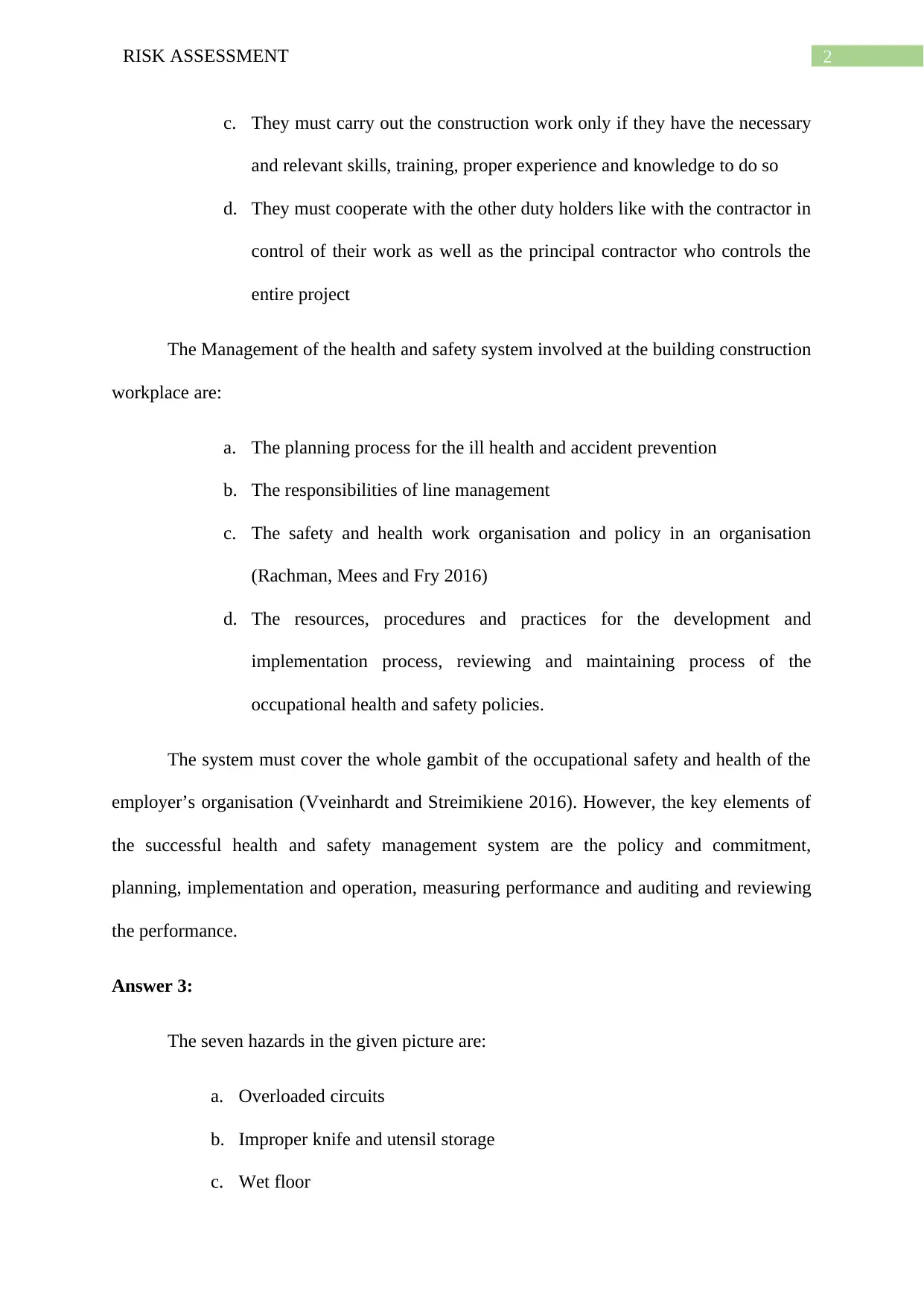
2RISK ASSESSMENT
c. They must carry out the construction work only if they have the necessary
and relevant skills, training, proper experience and knowledge to do so
d. They must cooperate with the other duty holders like with the contractor in
control of their work as well as the principal contractor who controls the
entire project
The Management of the health and safety system involved at the building construction
workplace are:
a. The planning process for the ill health and accident prevention
b. The responsibilities of line management
c. The safety and health work organisation and policy in an organisation
(Rachman, Mees and Fry 2016)
d. The resources, procedures and practices for the development and
implementation process, reviewing and maintaining process of the
occupational health and safety policies.
The system must cover the whole gambit of the occupational safety and health of the
employer’s organisation (Vveinhardt and Streimikiene 2016). However, the key elements of
the successful health and safety management system are the policy and commitment,
planning, implementation and operation, measuring performance and auditing and reviewing
the performance.
Answer 3:
The seven hazards in the given picture are:
a. Overloaded circuits
b. Improper knife and utensil storage
c. Wet floor
c. They must carry out the construction work only if they have the necessary
and relevant skills, training, proper experience and knowledge to do so
d. They must cooperate with the other duty holders like with the contractor in
control of their work as well as the principal contractor who controls the
entire project
The Management of the health and safety system involved at the building construction
workplace are:
a. The planning process for the ill health and accident prevention
b. The responsibilities of line management
c. The safety and health work organisation and policy in an organisation
(Rachman, Mees and Fry 2016)
d. The resources, procedures and practices for the development and
implementation process, reviewing and maintaining process of the
occupational health and safety policies.
The system must cover the whole gambit of the occupational safety and health of the
employer’s organisation (Vveinhardt and Streimikiene 2016). However, the key elements of
the successful health and safety management system are the policy and commitment,
planning, implementation and operation, measuring performance and auditing and reviewing
the performance.
Answer 3:
The seven hazards in the given picture are:
a. Overloaded circuits
b. Improper knife and utensil storage
c. Wet floor
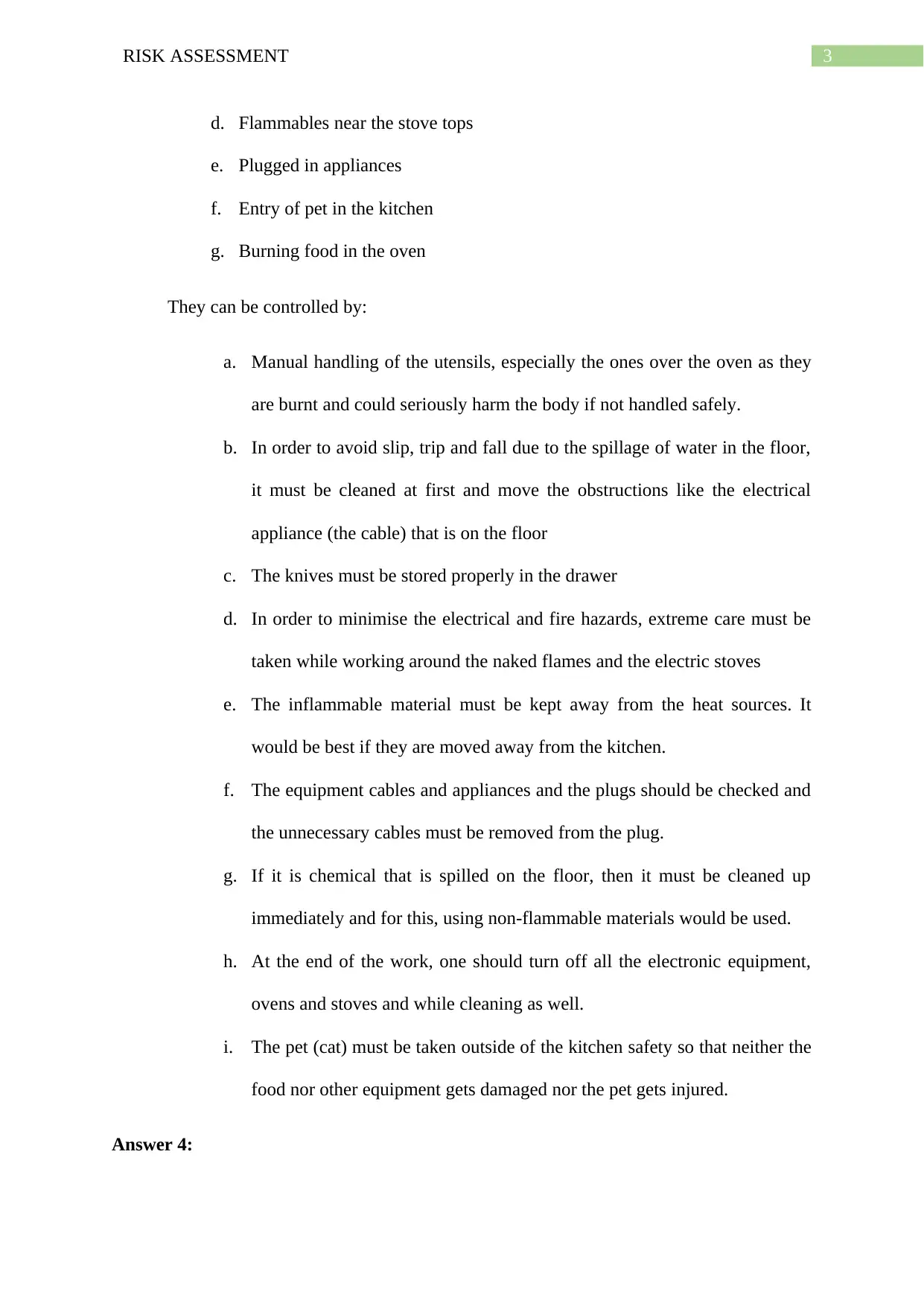
3RISK ASSESSMENT
d. Flammables near the stove tops
e. Plugged in appliances
f. Entry of pet in the kitchen
g. Burning food in the oven
They can be controlled by:
a. Manual handling of the utensils, especially the ones over the oven as they
are burnt and could seriously harm the body if not handled safely.
b. In order to avoid slip, trip and fall due to the spillage of water in the floor,
it must be cleaned at first and move the obstructions like the electrical
appliance (the cable) that is on the floor
c. The knives must be stored properly in the drawer
d. In order to minimise the electrical and fire hazards, extreme care must be
taken while working around the naked flames and the electric stoves
e. The inflammable material must be kept away from the heat sources. It
would be best if they are moved away from the kitchen.
f. The equipment cables and appliances and the plugs should be checked and
the unnecessary cables must be removed from the plug.
g. If it is chemical that is spilled on the floor, then it must be cleaned up
immediately and for this, using non-flammable materials would be used.
h. At the end of the work, one should turn off all the electronic equipment,
ovens and stoves and while cleaning as well.
i. The pet (cat) must be taken outside of the kitchen safety so that neither the
food nor other equipment gets damaged nor the pet gets injured.
Answer 4:
d. Flammables near the stove tops
e. Plugged in appliances
f. Entry of pet in the kitchen
g. Burning food in the oven
They can be controlled by:
a. Manual handling of the utensils, especially the ones over the oven as they
are burnt and could seriously harm the body if not handled safely.
b. In order to avoid slip, trip and fall due to the spillage of water in the floor,
it must be cleaned at first and move the obstructions like the electrical
appliance (the cable) that is on the floor
c. The knives must be stored properly in the drawer
d. In order to minimise the electrical and fire hazards, extreme care must be
taken while working around the naked flames and the electric stoves
e. The inflammable material must be kept away from the heat sources. It
would be best if they are moved away from the kitchen.
f. The equipment cables and appliances and the plugs should be checked and
the unnecessary cables must be removed from the plug.
g. If it is chemical that is spilled on the floor, then it must be cleaned up
immediately and for this, using non-flammable materials would be used.
h. At the end of the work, one should turn off all the electronic equipment,
ovens and stoves and while cleaning as well.
i. The pet (cat) must be taken outside of the kitchen safety so that neither the
food nor other equipment gets damaged nor the pet gets injured.
Answer 4:
Secure Best Marks with AI Grader
Need help grading? Try our AI Grader for instant feedback on your assignments.
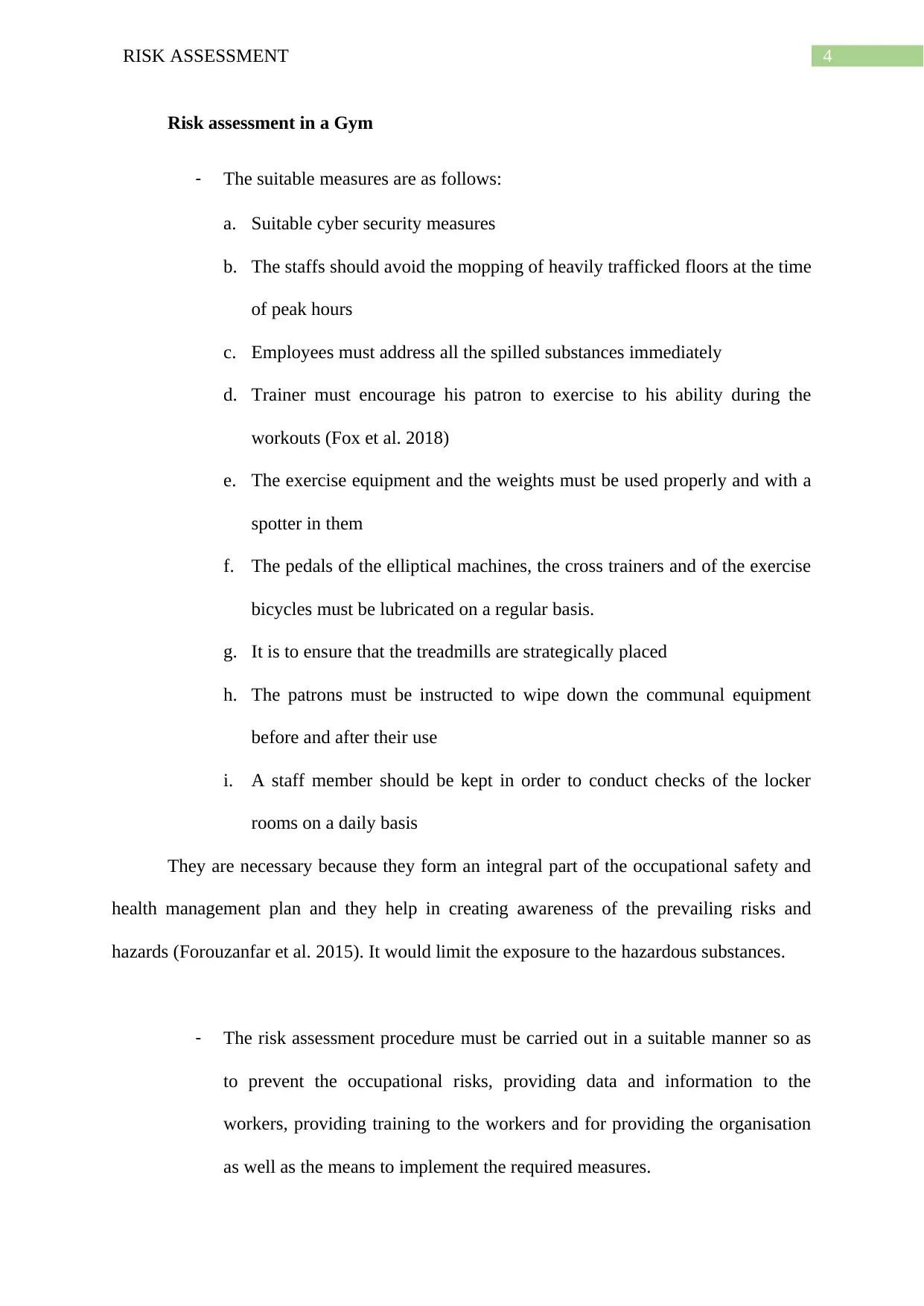
4RISK ASSESSMENT
Risk assessment in a Gym
- The suitable measures are as follows:
a. Suitable cyber security measures
b. The staffs should avoid the mopping of heavily trafficked floors at the time
of peak hours
c. Employees must address all the spilled substances immediately
d. Trainer must encourage his patron to exercise to his ability during the
workouts (Fox et al. 2018)
e. The exercise equipment and the weights must be used properly and with a
spotter in them
f. The pedals of the elliptical machines, the cross trainers and of the exercise
bicycles must be lubricated on a regular basis.
g. It is to ensure that the treadmills are strategically placed
h. The patrons must be instructed to wipe down the communal equipment
before and after their use
i. A staff member should be kept in order to conduct checks of the locker
rooms on a daily basis
They are necessary because they form an integral part of the occupational safety and
health management plan and they help in creating awareness of the prevailing risks and
hazards (Forouzanfar et al. 2015). It would limit the exposure to the hazardous substances.
- The risk assessment procedure must be carried out in a suitable manner so as
to prevent the occupational risks, providing data and information to the
workers, providing training to the workers and for providing the organisation
as well as the means to implement the required measures.
Risk assessment in a Gym
- The suitable measures are as follows:
a. Suitable cyber security measures
b. The staffs should avoid the mopping of heavily trafficked floors at the time
of peak hours
c. Employees must address all the spilled substances immediately
d. Trainer must encourage his patron to exercise to his ability during the
workouts (Fox et al. 2018)
e. The exercise equipment and the weights must be used properly and with a
spotter in them
f. The pedals of the elliptical machines, the cross trainers and of the exercise
bicycles must be lubricated on a regular basis.
g. It is to ensure that the treadmills are strategically placed
h. The patrons must be instructed to wipe down the communal equipment
before and after their use
i. A staff member should be kept in order to conduct checks of the locker
rooms on a daily basis
They are necessary because they form an integral part of the occupational safety and
health management plan and they help in creating awareness of the prevailing risks and
hazards (Forouzanfar et al. 2015). It would limit the exposure to the hazardous substances.
- The risk assessment procedure must be carried out in a suitable manner so as
to prevent the occupational risks, providing data and information to the
workers, providing training to the workers and for providing the organisation
as well as the means to implement the required measures.
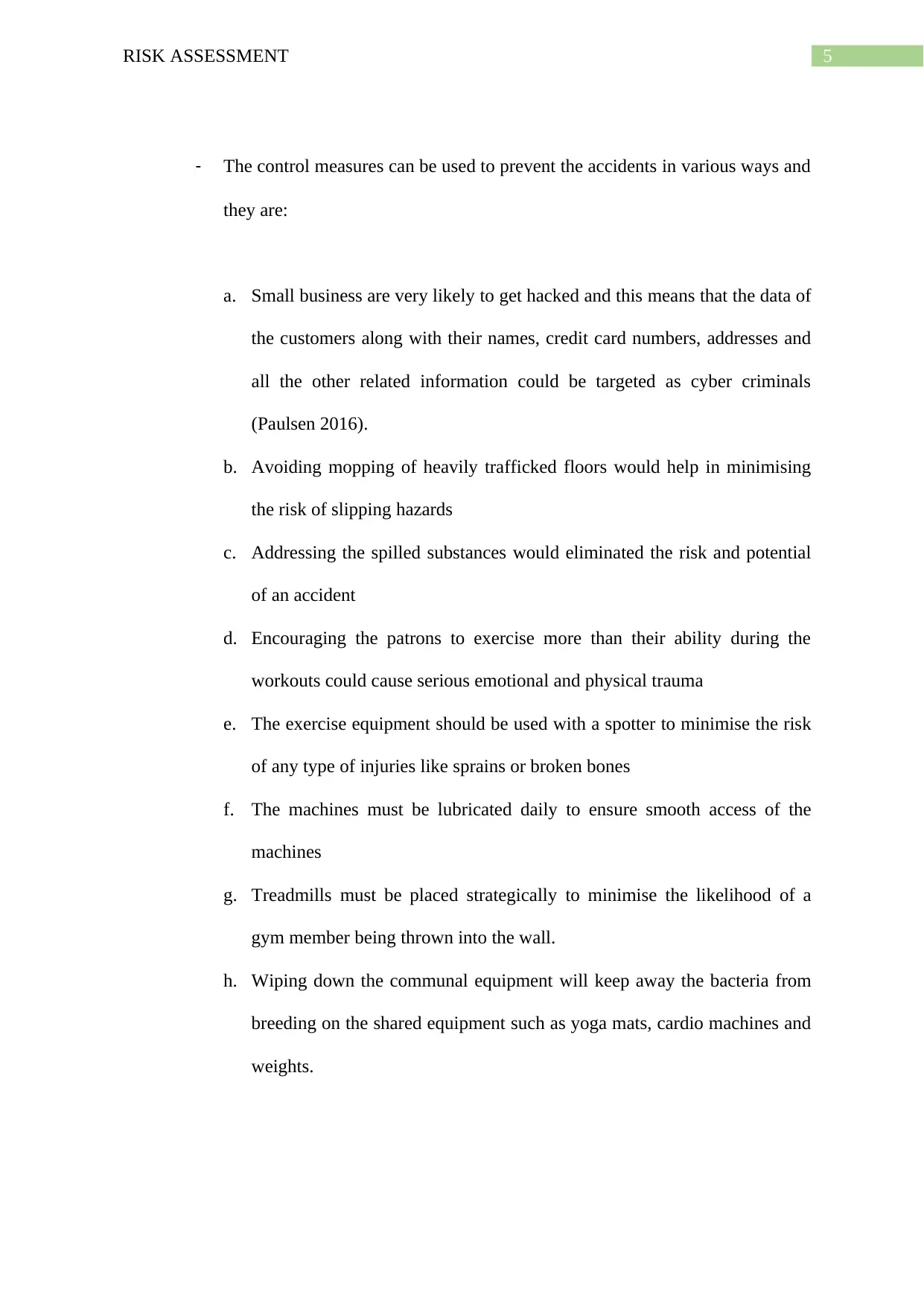
5RISK ASSESSMENT
- The control measures can be used to prevent the accidents in various ways and
they are:
a. Small business are very likely to get hacked and this means that the data of
the customers along with their names, credit card numbers, addresses and
all the other related information could be targeted as cyber criminals
(Paulsen 2016).
b. Avoiding mopping of heavily trafficked floors would help in minimising
the risk of slipping hazards
c. Addressing the spilled substances would eliminated the risk and potential
of an accident
d. Encouraging the patrons to exercise more than their ability during the
workouts could cause serious emotional and physical trauma
e. The exercise equipment should be used with a spotter to minimise the risk
of any type of injuries like sprains or broken bones
f. The machines must be lubricated daily to ensure smooth access of the
machines
g. Treadmills must be placed strategically to minimise the likelihood of a
gym member being thrown into the wall.
h. Wiping down the communal equipment will keep away the bacteria from
breeding on the shared equipment such as yoga mats, cardio machines and
weights.
- The control measures can be used to prevent the accidents in various ways and
they are:
a. Small business are very likely to get hacked and this means that the data of
the customers along with their names, credit card numbers, addresses and
all the other related information could be targeted as cyber criminals
(Paulsen 2016).
b. Avoiding mopping of heavily trafficked floors would help in minimising
the risk of slipping hazards
c. Addressing the spilled substances would eliminated the risk and potential
of an accident
d. Encouraging the patrons to exercise more than their ability during the
workouts could cause serious emotional and physical trauma
e. The exercise equipment should be used with a spotter to minimise the risk
of any type of injuries like sprains or broken bones
f. The machines must be lubricated daily to ensure smooth access of the
machines
g. Treadmills must be placed strategically to minimise the likelihood of a
gym member being thrown into the wall.
h. Wiping down the communal equipment will keep away the bacteria from
breeding on the shared equipment such as yoga mats, cardio machines and
weights.
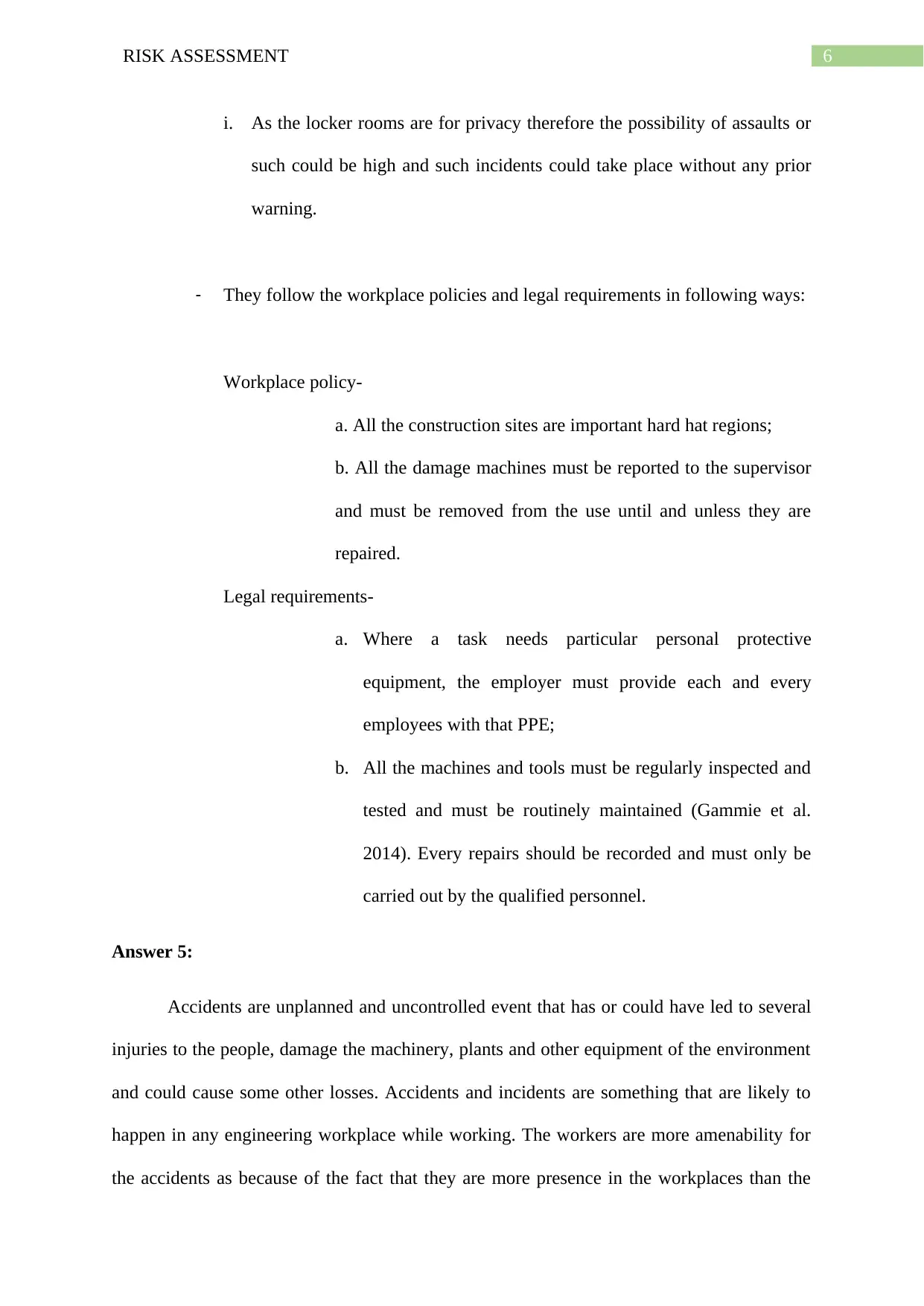
6RISK ASSESSMENT
i. As the locker rooms are for privacy therefore the possibility of assaults or
such could be high and such incidents could take place without any prior
warning.
- They follow the workplace policies and legal requirements in following ways:
Workplace policy-
a. All the construction sites are important hard hat regions;
b. All the damage machines must be reported to the supervisor
and must be removed from the use until and unless they are
repaired.
Legal requirements-
a. Where a task needs particular personal protective
equipment, the employer must provide each and every
employees with that PPE;
b. All the machines and tools must be regularly inspected and
tested and must be routinely maintained (Gammie et al.
2014). Every repairs should be recorded and must only be
carried out by the qualified personnel.
Answer 5:
Accidents are unplanned and uncontrolled event that has or could have led to several
injuries to the people, damage the machinery, plants and other equipment of the environment
and could cause some other losses. Accidents and incidents are something that are likely to
happen in any engineering workplace while working. The workers are more amenability for
the accidents as because of the fact that they are more presence in the workplaces than the
i. As the locker rooms are for privacy therefore the possibility of assaults or
such could be high and such incidents could take place without any prior
warning.
- They follow the workplace policies and legal requirements in following ways:
Workplace policy-
a. All the construction sites are important hard hat regions;
b. All the damage machines must be reported to the supervisor
and must be removed from the use until and unless they are
repaired.
Legal requirements-
a. Where a task needs particular personal protective
equipment, the employer must provide each and every
employees with that PPE;
b. All the machines and tools must be regularly inspected and
tested and must be routinely maintained (Gammie et al.
2014). Every repairs should be recorded and must only be
carried out by the qualified personnel.
Answer 5:
Accidents are unplanned and uncontrolled event that has or could have led to several
injuries to the people, damage the machinery, plants and other equipment of the environment
and could cause some other losses. Accidents and incidents are something that are likely to
happen in any engineering workplace while working. The workers are more amenability for
the accidents as because of the fact that they are more presence in the workplaces than the
Paraphrase This Document
Need a fresh take? Get an instant paraphrase of this document with our AI Paraphraser
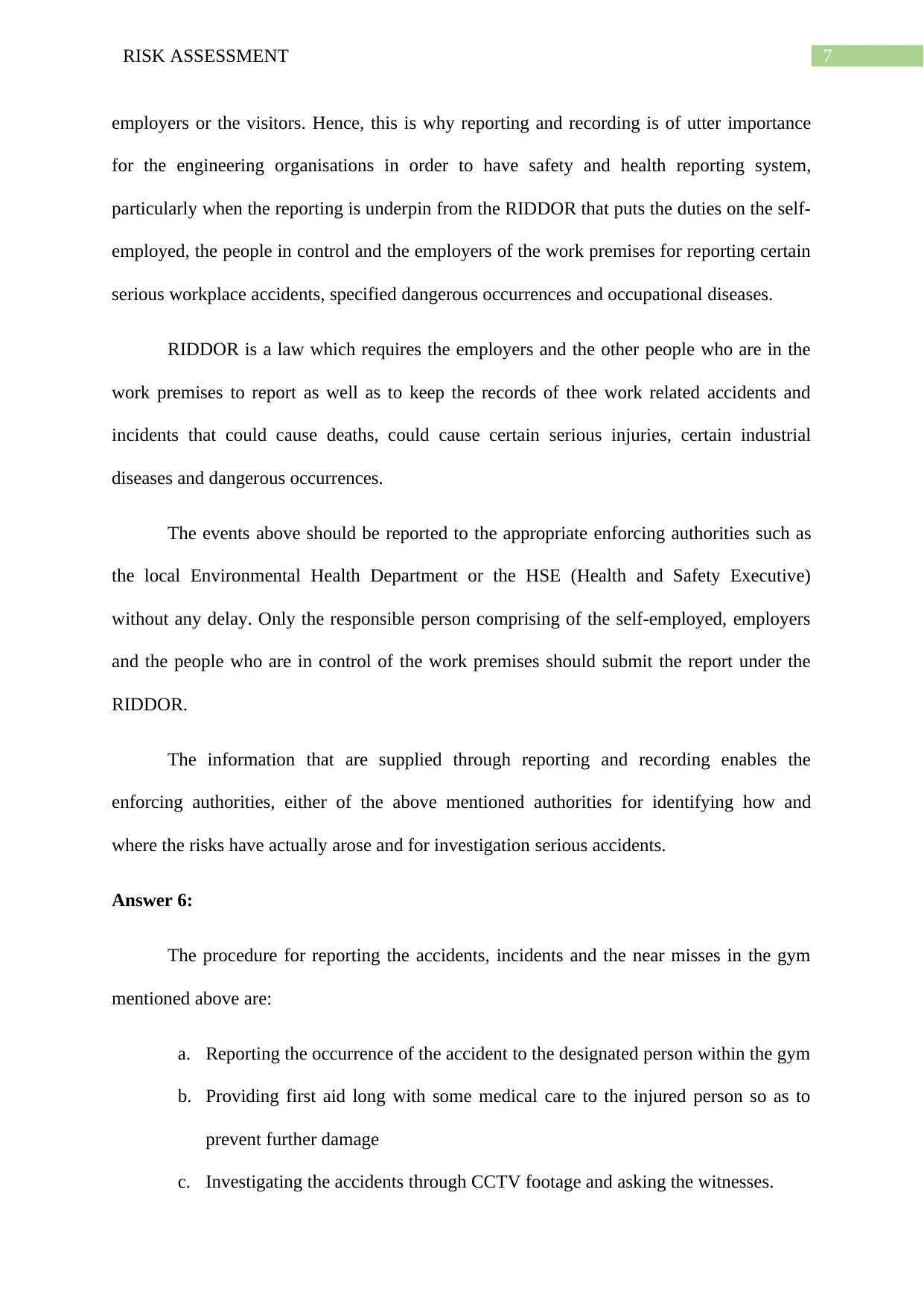
7RISK ASSESSMENT
employers or the visitors. Hence, this is why reporting and recording is of utter importance
for the engineering organisations in order to have safety and health reporting system,
particularly when the reporting is underpin from the RIDDOR that puts the duties on the self-
employed, the people in control and the employers of the work premises for reporting certain
serious workplace accidents, specified dangerous occurrences and occupational diseases.
RIDDOR is a law which requires the employers and the other people who are in the
work premises to report as well as to keep the records of thee work related accidents and
incidents that could cause deaths, could cause certain serious injuries, certain industrial
diseases and dangerous occurrences.
The events above should be reported to the appropriate enforcing authorities such as
the local Environmental Health Department or the HSE (Health and Safety Executive)
without any delay. Only the responsible person comprising of the self-employed, employers
and the people who are in control of the work premises should submit the report under the
RIDDOR.
The information that are supplied through reporting and recording enables the
enforcing authorities, either of the above mentioned authorities for identifying how and
where the risks have actually arose and for investigation serious accidents.
Answer 6:
The procedure for reporting the accidents, incidents and the near misses in the gym
mentioned above are:
a. Reporting the occurrence of the accident to the designated person within the gym
b. Providing first aid long with some medical care to the injured person so as to
prevent further damage
c. Investigating the accidents through CCTV footage and asking the witnesses.
employers or the visitors. Hence, this is why reporting and recording is of utter importance
for the engineering organisations in order to have safety and health reporting system,
particularly when the reporting is underpin from the RIDDOR that puts the duties on the self-
employed, the people in control and the employers of the work premises for reporting certain
serious workplace accidents, specified dangerous occurrences and occupational diseases.
RIDDOR is a law which requires the employers and the other people who are in the
work premises to report as well as to keep the records of thee work related accidents and
incidents that could cause deaths, could cause certain serious injuries, certain industrial
diseases and dangerous occurrences.
The events above should be reported to the appropriate enforcing authorities such as
the local Environmental Health Department or the HSE (Health and Safety Executive)
without any delay. Only the responsible person comprising of the self-employed, employers
and the people who are in control of the work premises should submit the report under the
RIDDOR.
The information that are supplied through reporting and recording enables the
enforcing authorities, either of the above mentioned authorities for identifying how and
where the risks have actually arose and for investigation serious accidents.
Answer 6:
The procedure for reporting the accidents, incidents and the near misses in the gym
mentioned above are:
a. Reporting the occurrence of the accident to the designated person within the gym
b. Providing first aid long with some medical care to the injured person so as to
prevent further damage
c. Investigating the accidents through CCTV footage and asking the witnesses.
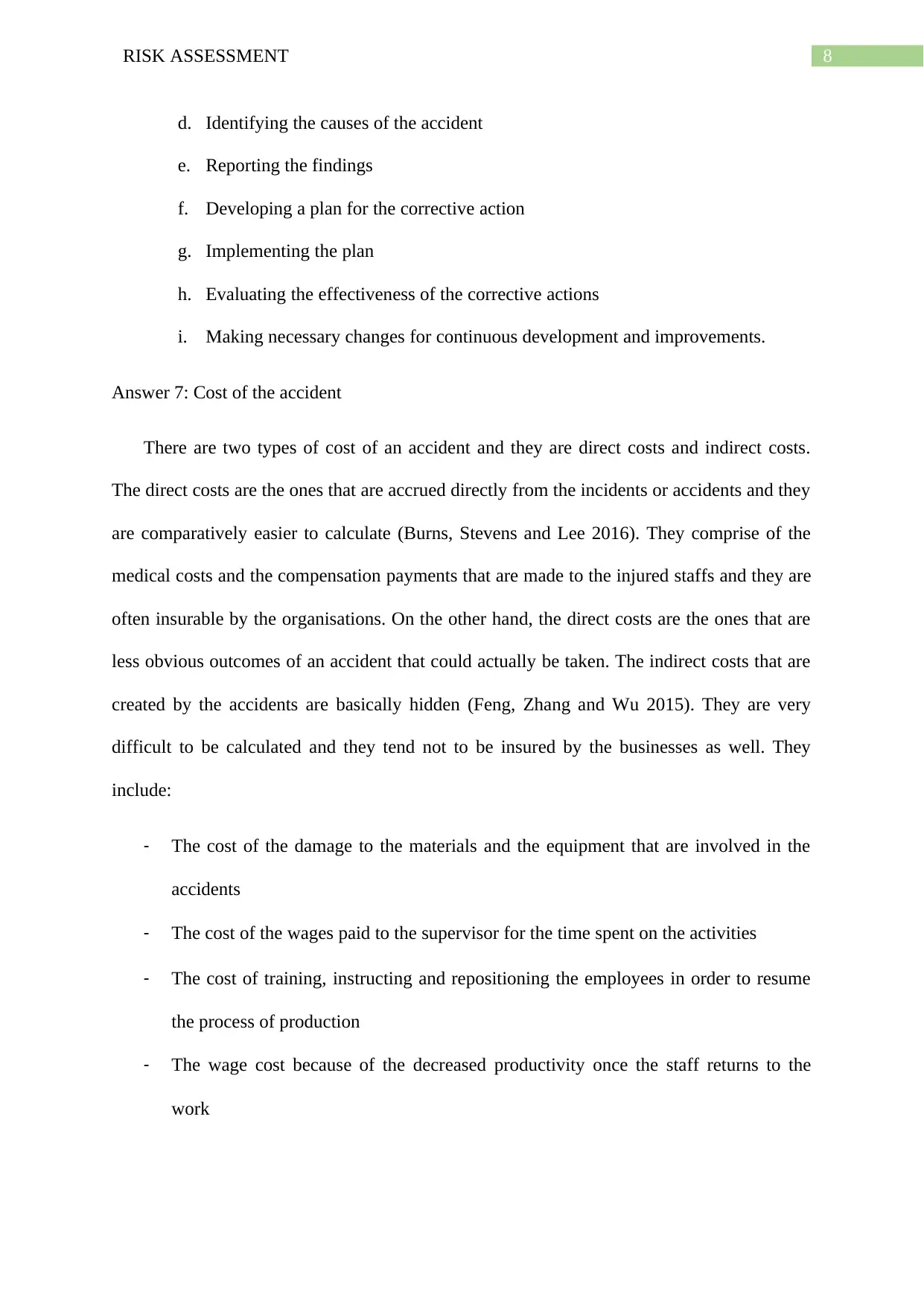
8RISK ASSESSMENT
d. Identifying the causes of the accident
e. Reporting the findings
f. Developing a plan for the corrective action
g. Implementing the plan
h. Evaluating the effectiveness of the corrective actions
i. Making necessary changes for continuous development and improvements.
Answer 7: Cost of the accident
There are two types of cost of an accident and they are direct costs and indirect costs.
The direct costs are the ones that are accrued directly from the incidents or accidents and they
are comparatively easier to calculate (Burns, Stevens and Lee 2016). They comprise of the
medical costs and the compensation payments that are made to the injured staffs and they are
often insurable by the organisations. On the other hand, the direct costs are the ones that are
less obvious outcomes of an accident that could actually be taken. The indirect costs that are
created by the accidents are basically hidden (Feng, Zhang and Wu 2015). They are very
difficult to be calculated and they tend not to be insured by the businesses as well. They
include:
- The cost of the damage to the materials and the equipment that are involved in the
accidents
- The cost of the wages paid to the supervisor for the time spent on the activities
- The cost of training, instructing and repositioning the employees in order to resume
the process of production
- The wage cost because of the decreased productivity once the staff returns to the
work
d. Identifying the causes of the accident
e. Reporting the findings
f. Developing a plan for the corrective action
g. Implementing the plan
h. Evaluating the effectiveness of the corrective actions
i. Making necessary changes for continuous development and improvements.
Answer 7: Cost of the accident
There are two types of cost of an accident and they are direct costs and indirect costs.
The direct costs are the ones that are accrued directly from the incidents or accidents and they
are comparatively easier to calculate (Burns, Stevens and Lee 2016). They comprise of the
medical costs and the compensation payments that are made to the injured staffs and they are
often insurable by the organisations. On the other hand, the direct costs are the ones that are
less obvious outcomes of an accident that could actually be taken. The indirect costs that are
created by the accidents are basically hidden (Feng, Zhang and Wu 2015). They are very
difficult to be calculated and they tend not to be insured by the businesses as well. They
include:
- The cost of the damage to the materials and the equipment that are involved in the
accidents
- The cost of the wages paid to the supervisor for the time spent on the activities
- The cost of training, instructing and repositioning the employees in order to resume
the process of production
- The wage cost because of the decreased productivity once the staff returns to the
work
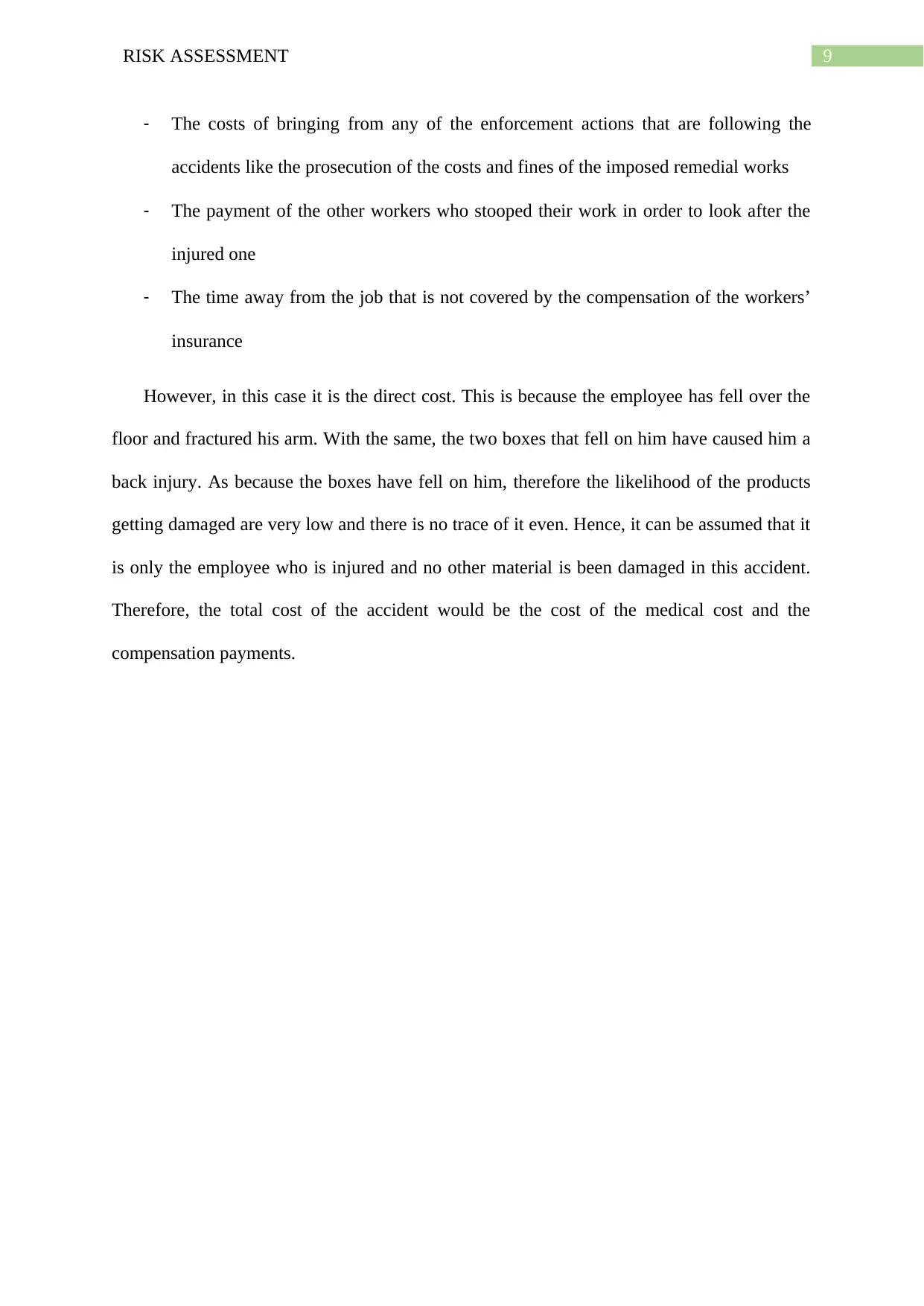
9RISK ASSESSMENT
- The costs of bringing from any of the enforcement actions that are following the
accidents like the prosecution of the costs and fines of the imposed remedial works
- The payment of the other workers who stooped their work in order to look after the
injured one
- The time away from the job that is not covered by the compensation of the workers’
insurance
However, in this case it is the direct cost. This is because the employee has fell over the
floor and fractured his arm. With the same, the two boxes that fell on him have caused him a
back injury. As because the boxes have fell on him, therefore the likelihood of the products
getting damaged are very low and there is no trace of it even. Hence, it can be assumed that it
is only the employee who is injured and no other material is been damaged in this accident.
Therefore, the total cost of the accident would be the cost of the medical cost and the
compensation payments.
- The costs of bringing from any of the enforcement actions that are following the
accidents like the prosecution of the costs and fines of the imposed remedial works
- The payment of the other workers who stooped their work in order to look after the
injured one
- The time away from the job that is not covered by the compensation of the workers’
insurance
However, in this case it is the direct cost. This is because the employee has fell over the
floor and fractured his arm. With the same, the two boxes that fell on him have caused him a
back injury. As because the boxes have fell on him, therefore the likelihood of the products
getting damaged are very low and there is no trace of it even. Hence, it can be assumed that it
is only the employee who is injured and no other material is been damaged in this accident.
Therefore, the total cost of the accident would be the cost of the medical cost and the
compensation payments.
Secure Best Marks with AI Grader
Need help grading? Try our AI Grader for instant feedback on your assignments.
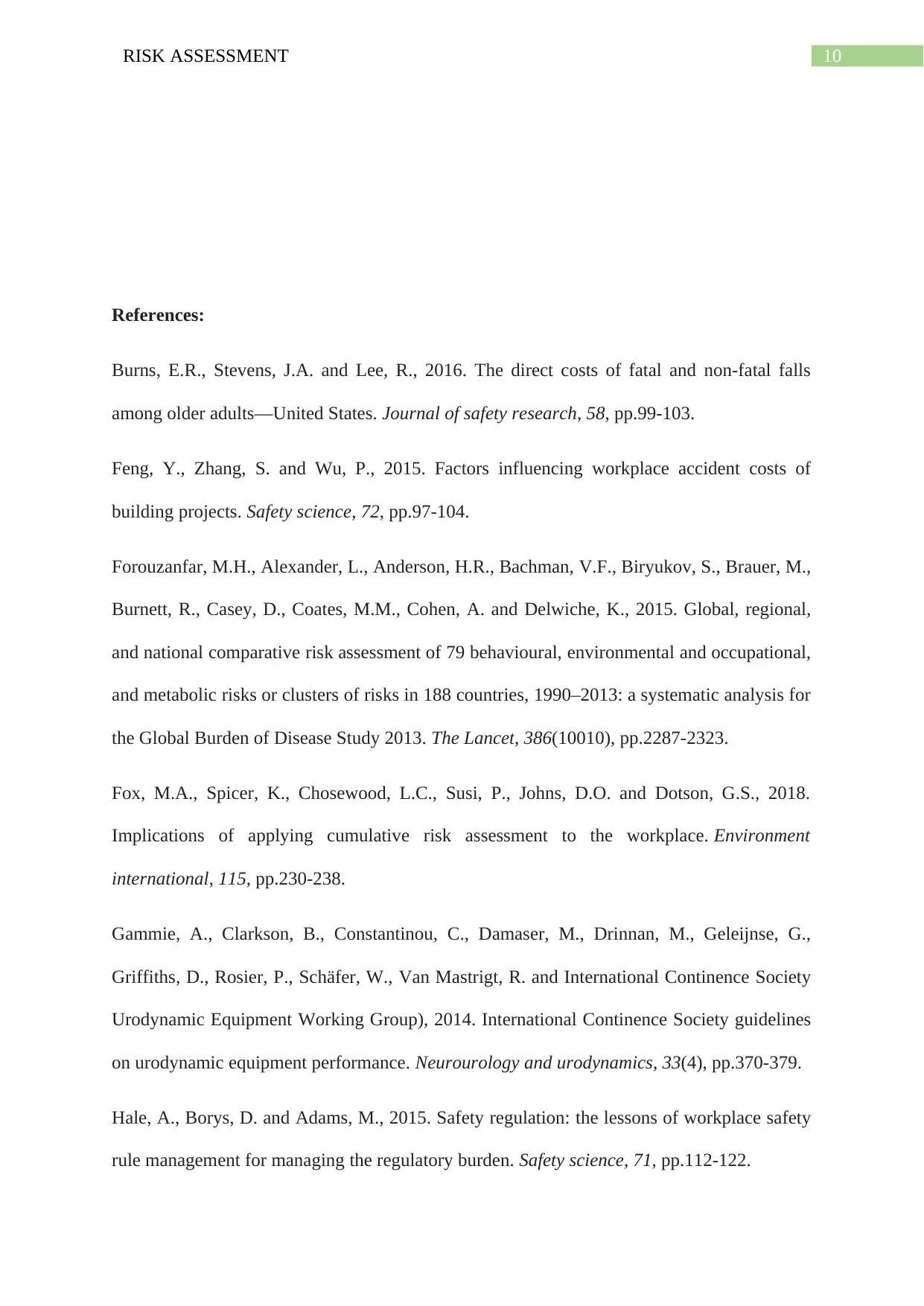
10RISK ASSESSMENT
References:
Burns, E.R., Stevens, J.A. and Lee, R., 2016. The direct costs of fatal and non-fatal falls
among older adults—United States. Journal of safety research, 58, pp.99-103.
Feng, Y., Zhang, S. and Wu, P., 2015. Factors influencing workplace accident costs of
building projects. Safety science, 72, pp.97-104.
Forouzanfar, M.H., Alexander, L., Anderson, H.R., Bachman, V.F., Biryukov, S., Brauer, M.,
Burnett, R., Casey, D., Coates, M.M., Cohen, A. and Delwiche, K., 2015. Global, regional,
and national comparative risk assessment of 79 behavioural, environmental and occupational,
and metabolic risks or clusters of risks in 188 countries, 1990–2013: a systematic analysis for
the Global Burden of Disease Study 2013. The Lancet, 386(10010), pp.2287-2323.
Fox, M.A., Spicer, K., Chosewood, L.C., Susi, P., Johns, D.O. and Dotson, G.S., 2018.
Implications of applying cumulative risk assessment to the workplace. Environment
international, 115, pp.230-238.
Gammie, A., Clarkson, B., Constantinou, C., Damaser, M., Drinnan, M., Geleijnse, G.,
Griffiths, D., Rosier, P., Schäfer, W., Van Mastrigt, R. and International Continence Society
Urodynamic Equipment Working Group), 2014. International Continence Society guidelines
on urodynamic equipment performance. Neurourology and urodynamics, 33(4), pp.370-379.
Hale, A., Borys, D. and Adams, M., 2015. Safety regulation: the lessons of workplace safety
rule management for managing the regulatory burden. Safety science, 71, pp.112-122.
References:
Burns, E.R., Stevens, J.A. and Lee, R., 2016. The direct costs of fatal and non-fatal falls
among older adults—United States. Journal of safety research, 58, pp.99-103.
Feng, Y., Zhang, S. and Wu, P., 2015. Factors influencing workplace accident costs of
building projects. Safety science, 72, pp.97-104.
Forouzanfar, M.H., Alexander, L., Anderson, H.R., Bachman, V.F., Biryukov, S., Brauer, M.,
Burnett, R., Casey, D., Coates, M.M., Cohen, A. and Delwiche, K., 2015. Global, regional,
and national comparative risk assessment of 79 behavioural, environmental and occupational,
and metabolic risks or clusters of risks in 188 countries, 1990–2013: a systematic analysis for
the Global Burden of Disease Study 2013. The Lancet, 386(10010), pp.2287-2323.
Fox, M.A., Spicer, K., Chosewood, L.C., Susi, P., Johns, D.O. and Dotson, G.S., 2018.
Implications of applying cumulative risk assessment to the workplace. Environment
international, 115, pp.230-238.
Gammie, A., Clarkson, B., Constantinou, C., Damaser, M., Drinnan, M., Geleijnse, G.,
Griffiths, D., Rosier, P., Schäfer, W., Van Mastrigt, R. and International Continence Society
Urodynamic Equipment Working Group), 2014. International Continence Society guidelines
on urodynamic equipment performance. Neurourology and urodynamics, 33(4), pp.370-379.
Hale, A., Borys, D. and Adams, M., 2015. Safety regulation: the lessons of workplace safety
rule management for managing the regulatory burden. Safety science, 71, pp.112-122.
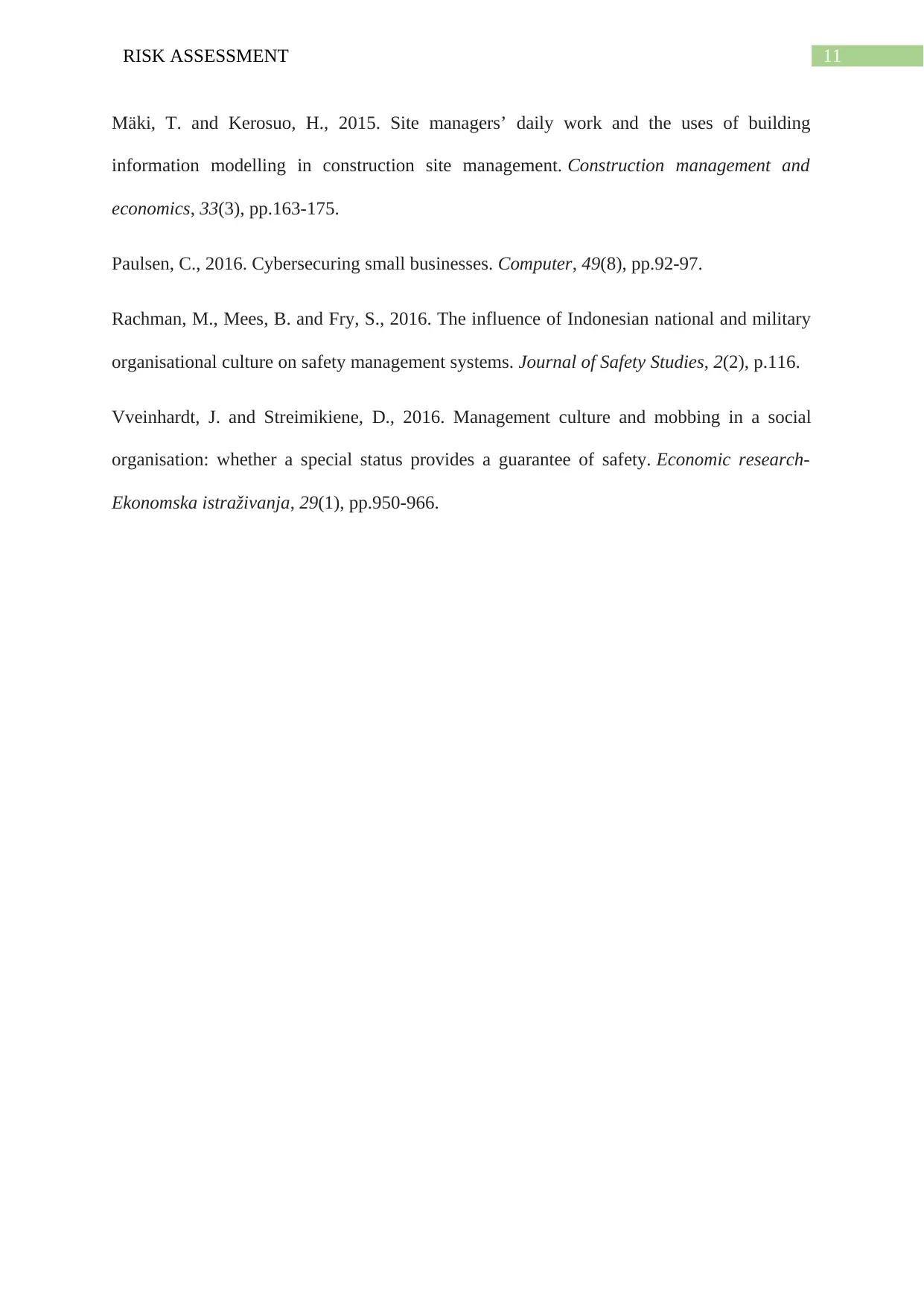
11RISK ASSESSMENT
Mäki, T. and Kerosuo, H., 2015. Site managers’ daily work and the uses of building
information modelling in construction site management. Construction management and
economics, 33(3), pp.163-175.
Paulsen, C., 2016. Cybersecuring small businesses. Computer, 49(8), pp.92-97.
Rachman, M., Mees, B. and Fry, S., 2016. The influence of Indonesian national and military
organisational culture on safety management systems. Journal of Safety Studies, 2(2), p.116.
Vveinhardt, J. and Streimikiene, D., 2016. Management culture and mobbing in a social
organisation: whether a special status provides a guarantee of safety. Economic research-
Ekonomska istraživanja, 29(1), pp.950-966.
Mäki, T. and Kerosuo, H., 2015. Site managers’ daily work and the uses of building
information modelling in construction site management. Construction management and
economics, 33(3), pp.163-175.
Paulsen, C., 2016. Cybersecuring small businesses. Computer, 49(8), pp.92-97.
Rachman, M., Mees, B. and Fry, S., 2016. The influence of Indonesian national and military
organisational culture on safety management systems. Journal of Safety Studies, 2(2), p.116.
Vveinhardt, J. and Streimikiene, D., 2016. Management culture and mobbing in a social
organisation: whether a special status provides a guarantee of safety. Economic research-
Ekonomska istraživanja, 29(1), pp.950-966.
1 out of 12
Related Documents
Your All-in-One AI-Powered Toolkit for Academic Success.
+13062052269
info@desklib.com
Available 24*7 on WhatsApp / Email
![[object Object]](/_next/static/media/star-bottom.7253800d.svg)
Unlock your academic potential
© 2024 | Zucol Services PVT LTD | All rights reserved.





